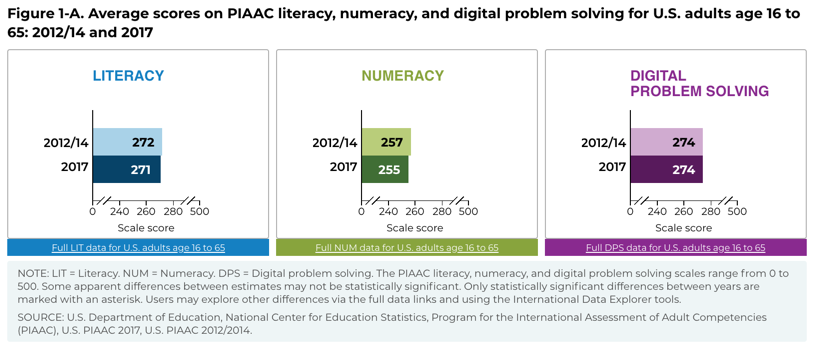New Data: Web-Based “First Look” Report on Recent Trend Results in Adult Literacy in the United States
From the National Center For Education Statistics :
Between 2012/14 and 2017, the average scores for U.S. adults with less than a high school education increased in literacy, while, for adults with a high school education, they decreased in both literacy and numeracy.
The National Center for Education Statistics released a new web-based first look report today November 15, 2019, entitled “U.S. PIAAC 2017 First Look Web Report.”
This web-based first look report summarizes what data from the Program for the International Assessment of Adult Competencies (PIAAC) show about recent trend in adult literacy in the United States.
The findings include the following:
- Average scores for U.S. adults age 16–65 were not measurably different in literacy, numeracy, or digital problem solving in 2017 compared to 2012/2014. Nineteen percent of adults performed at or below the lowest level in literacy, 29 percent performed at that same level in numeracy, and 24 percent of adults scored below the lowest level in digital problem solving.
- Hispanic adults (age 16–65) in the United States scored higher in both literacy and digital problem solving in 2017 compared to 2012/14. The average scores of White and Black adults showed no significant change across all three domains over this time period.
- Non-native-born adults (age 16–65) in the United States scored higher in 2017 in both literacy and digital problem solving than they did in 2012/14.
- Score gaps between unemployed and employed adults age 16–65 closed for all three skill areas between 2012/14 and 2017, with no measurable difference between the groups’ average scores in 2017. Unemployed adults’ scores increased in both literacy and numeracy.
- From 2012/14 to 2017, the percentage of U.S. adults ages 16–65 with less than a high school education decreased from 14% to 12%, and the percentage with more than a high school education increased from 45% to 48%. In 2017, U.S. adults with less than a high school education had higher average scores in literacy compared to 2012/14, while adults with only a high school education had lower average scores in both literacy and numeracy compared to 2012/14.
PIAAC is a large-scale international study of working-age adults (ages 16–65) that assesses adult skills in three domains (literacy, numeracy, and digital problem solving) and collects information on adults’ education, work experience, and other background characteristics.
PIAAC was developed and organized by the Organization for Economic Cooperation and Development (OECD). In the United States, PIAAC was conducted by the National Center for Education Statistics (NCES) of the Institute of Education Sciences within the U.S. Department of Education.
Direct to Full Text Report
Filed under: Data Files, News, Reports
About Gary Price
Gary Price (gprice@gmail.com) is a librarian, writer, consultant, and frequent conference speaker based in the Washington D.C. metro area. He earned his MLIS degree from Wayne State University in Detroit. Price has won several awards including the SLA Innovations in Technology Award and Alumnus of the Year from the Wayne St. University Library and Information Science Program. From 2006-2009 he was Director of Online Information Services at Ask.com.



